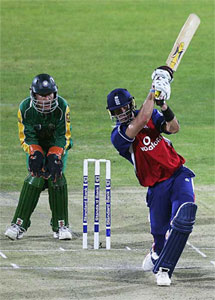|
|
||||||||
|
||||||||
Bedtime For Pyjama Cricket Watching England’s dismal demise in the recent one-day cricket series in India left me with one overriding emotion: disinterest. How can it be that a game I love being played at the highest level by historic rivals can so comprehensively fail to arouse my sporting passions? The reason is simple. One-day cricket has become boring and predictable. In an era of four-an-over Tests and Twenty20 fireworks, there’s just no place for the 50-over one-day format. So let’s put pyjama cricket to bed and launch a Test match World Cup. ‘Imagine an Australia-England final packing in 80,000 for five days in a row at the MCG.’ It’s not as impractical as it sounds. Invite the top eight teams in the current Test rankings and stage it midsummer in a country with reliable weather (sorry England!). Split the teams into two pools of four and play the group games over a three-week period. Allow an extra fortnight for the semis and final and Robert’s your mother’s brother. You’re left with a five-week showpiece (one week shorter than the current World Cup) with the finest cricketers in the world playing the game the way it was meant to be played.
Imagine an Australia-England final packing in 80,000 for five days in a row at the MCG. India-Pakistan in Mumbai. Brian Lara blazing a double-ton for a resurgent West Indies at the Kensington Oval in Barbados. Mouth-watering stuff. When you really start thinking about it, you wonder why nobody had the idea years ago. Well, to be fair, there is a snag. What would you do about dreary draws? Surely you couldn’t have the World Test Match Final decided by a bowl-off? I’d get around this issue by handing victory to the team with the better run rate over the course of the match. On top of adding to the excitement for fans by rewarding attacking cricket, this would prohibit teams from plodding through the final day just to salvage a draw. ‘Shot-shy snails like Geoffrey Boycott and even Michael Atherton would look totally out-of-place in today’s Test arena.’ If this tinkering with the rule-book leaves a sour taste in the mouth of the cream tea-quaffing, blazer-wearing cricket traditionalist, well so what? The ruling would hardly ever come into play anyway. The speed at which teams score these days mean that the draw is becoming an endangered species. Australia’s barn-storming approach to Test cricket through the 1990s, during which they racked up a phenomenal 16 straight victories, has turned the game on its head. Shot-shy snails like Geoffrey Boycott and even Michael Atherton would look totally out-of-place in today’s Test arena. Even Jacques Kallis, South Africa’s batting colossus, is regularly criticized for his safety-first approach which can stall the momentum of an innings. One-day cricket has been running on empty for some time now. With the notable exception of the record-breaking and freakish recent run fest between Australia and South Africa, it is generally clear who is going to win long before the end and for the middle period of each innings. When the fields are pushed back and batsmen are chasing singles, the spectacle becomes desperately dull. The International Cricket Council are fully aware of this of course. Faced with declining attendances everywhere but in the cricket-mad subcontinent, they recently attempted to spice up the one-day game with footie-style “Supersubs”. This laughable idea proved unpopular with players and fans and was abandoned in March.
I’d take a more ruthless approach and gradually phase out the one-day game altogether. In English domestic cricket the phenomenal success of Twenty20 is leaving cash-strapped county teams hungry for more. The Twenty20 Cup has been expanded every year at the expense of one-day matches and there’s no reason why that trend should stop: David Acfield, the man who chaired the ECB committee which brought in the Twenty-20 format, fears he’s “spawned a monster.” I can see the same thing is happening in the international game. With the first ever Twenty20 world championship scheduled for next year, teams are going to want to play more of this utterly riveting game, which has drawn sell-out crowds to internationals in England, Australia, South Africa and New Zealand. The money men know a good thing when they see it and if it takes cheerleaders, rock music and jacuzzis to attract a full-house for a game against Sri Lanka then so be it. What we’d be left with is an international game in the rudest of health. Twenty20 packing out grounds with all it’s mind-yer-windows slogging and razzmatazz, and a Test match calendar that actually built towards a conclusion, with teams fine-tuning their squads for the four-yearly battle royale. Matthew Hoggard incurred the wrath of old stick-in-the-mud Boycott the other day for having the temerity to suggest that the Ashes were more important to England than the current World Cup. Not for the first time our shaggy-haired fast bowler was right on the mark. Could someone please shut Boycott up once and for all? |
|
|||||||
|
||||||||




